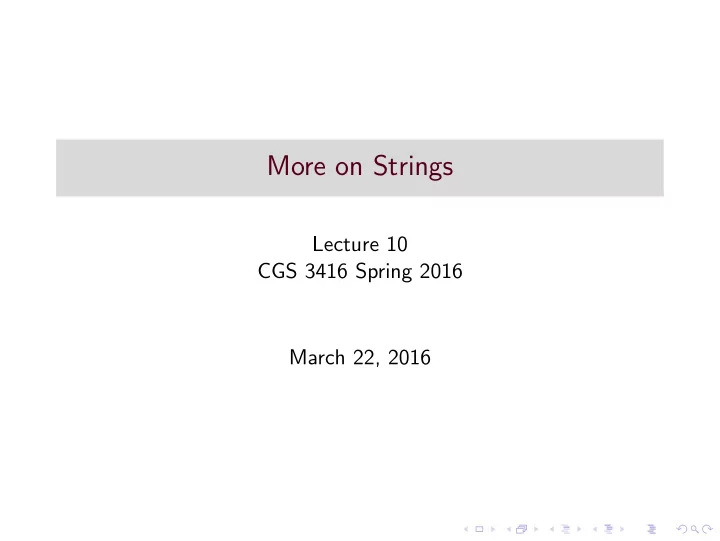

More on Strings Lecture 10 CGS 3416 Spring 2016 March 22, 2016
What we know so far ◮ In Java, a string is an object. ◮ The String class is used to create and store immutable strings. ◮ Some String class methods we have used before: ◮ equals() – for comparing two strings (i.e. their contents), returns true or false . ◮ equalsIgnoreCase() - just like equals() , except that the case of the letters doesn’t matter in making a match. ◮ compareTo() – also for comparing two strings, good for sorting. ◮ Don’t try to compare strings by using ==, < , > , etc. These would only compare the String reference variables, not the String objects themselves. ◮ Other comparison methods include regionMatches, startsWith, and endsWith . See String class API for full details.
Concatenation ◮ concat() – String concatenation. Returns a concatenation of two strings. String s1 = "Dog"; String s2 = "food"; String s3 = s1.concat(s2); //s3 now stores "Dogfood" //note: s1 and s2 are NOT changed ◮ The + symbol also performs String concatenation (as we’ve already used in print statements). String s1 = "Cat"; String s2 = "nap"; String s3 = s1 + s2; //s3 now stores "Catnap" (s1, s2 unchanged)
Substrings ◮ substring() – extracts part of a string and returns it. ◮ Takes in two parameters (begin index and end index) or 1 parameter (begin index). ◮ First character in a String has index 0. Substring returned is the index range [begin,end).
Substrings String s1 = "Hello, World"; String s2 = s1.substring(0,5);// s2 is now "Hello". // picks up indices 0 - 4 String s3 = s1.substring(0,7) + "Dolly"; System.out.print(s3);// prints "Hello, Dolly" System.out.print(s3.substring(4));//prints "o, Dolly" // can even use substring on string literals String s4= "What’s up doc?".substring(10,13); // s4="doc"
String length ◮ length() – returns a string’s length (number of characters). String s1 = "Hello"; String s2 = "Goodbye world"; System.out.print(s1.length()); // output: 5 System.out.print(s2.length()); // output: 13
charAt() method ◮ charAt() – returns a specific character, given an index. String s1 = "Rumplestiltskin"; System.out.print(s1.charAt(0)); // output: R System.out.print(s1.charAt(5)); // output: e System.out.print(s1.charAt(12)); // output: k
Some Conversion methods ◮ toLowerCase() – returns all lower case version of string ◮ toUpperCase() – returns all upper case version of string ◮ trim() – returns a string that eliminates leading and trailing blank characters from original ◮ replace() – returns a string with an old character replaced with a new one. old character and new character passed as parameters
Examples String s1 = "Zebra String s2 = s1.toLowerCase(); // s2 is "zebra" String s3 = s1.toUpperCase(); // s3 is "ZEBRA" String s4 = " Apple "; String s5 = s4.trim(); // s5 is "Apple" String s6 = s5.replace(‘e’, ‘y’); // s6 is "Apply"
valueOf() method ◮ valueOf() – there are several of these methods. ◮ They are static methods, and are used for converting other values to String objects int x = 12345; String s7 = String.valueOf(4.56); // s7 is "4.56" String s8 = String.valueOf(16); // s8 is "16" String s9 = String.valueOf(x); // s9 is "12345"
The StringBuilder Class ◮ The StringBuilder class is a part of the java.lang package. ◮ A StringBuilder object is mutable (i.e. it can be changed). ◮ Three of the four constructors shown here. Here are sample creations: ◮ creates an empty string builder with initial capacity of 16 characters StringBuilder buf1 = new StringBuilder(); ◮ creates empty string builder with initial capacity given in parameter StringBuilder buf2 = new StringBuilder(50); ◮ creates string builder filled with argument – initial capacity is length of given string plus 16 StringBuilder buf3 = new StringBuilder("Hello");
The append() method ◮ append() – adds data to string in the builder object, at the end. Several versions for different parameter types (see API for full set) StringBuilder buf1 = new StringBuilder(); buf1.append("Hello"); buf1.append(‘,’); buf1.append(" world!"); // buf1 is now "Hello, world!" buf1.append(‘ ’); buf1.append(123.45); // buf1 is now "Hello, world! 123.45"
The insert() method ◮ insert() – insert data at a certain starting index. Like append, multiple versions for different types of data (see API for full set) StringBuilder buf2 = new StringBuilder(); buf2.append("Welcome home"); // buf2 now "Welcome home" buf2.insert(8,"to my humble "); // buf2 = "Welcome to my humble home"
More StringBuilder methods ◮ delete() – delete data from a string builder object StringBuilder buf3 = new StringBuilder("abcdefghijklm"); buf3.delete(4,9); // deletes indices 4-8. buf3 is now "abcdjklm" ◮ deleteCharAt() – delete a character at specified index StringBuilder buf4 = new StringBuilder("abcdefg"); buf4.deleteCharAt(3); // buf4 is now "abcefg" buf4.deleteCharAt(1); // buf4 is now "acefg"
More StringBuilder methods ◮ reverse() – reverses the contents of the string builder ◮ setCharAt() – sets a character at specified index (similar to deleteCharAt() ◮ capacity() – returns current capacity of builder ◮ length() – returns length of current string in builder (less than or equal to capacity) ◮ setLength() – sets the exact length of the string in the builder to new value (parameter). ◮ This is the actual string, not the capacity. ◮ If the new length is smaller than previous length, characters are truncated from the string. ◮ If new length bigger, null characters are appended. ◮ charAt() – returns character at a specified index (parameter)
Recommend
More recommend